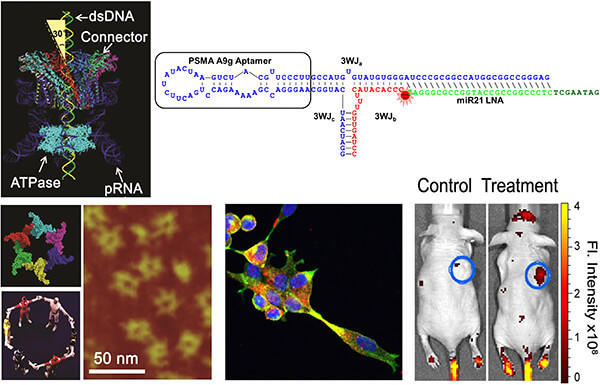Ohio State University and University of Kentucky — Optimizing RNA Nanoparticle's Size and Shape for Enhancing Cancer Targeting and Treatment
Principal Investigators: Peixuan Guo, Ph.D., William Carson, M.D., Jianhua Yu, Ph.D., and Daniel Pack, Ph.D.
Co-Investigators: Chris Richards, Ph.D.
Project Summary
The overall goal of this project is the systematic characterization of RNA nanoparticle behavior, in vitro and in vivo, to optimize its delivery to triple negative breast cancer (TNBC). RNA nanoparticles are unique in that their scaffold, ligand, and therapeutic components can all be composed of RNA. They are formed by the bottom up self-assembly, are biocompatible, water soluble, and thermodynamically stable. As such, RNA derived nanoparticles have been shown to be non-toxic therapeutic delivery systems with favorable biodistribution and pharmacokinetic profiles. The particles themselves are readily manipulated to create varying shapes and sizes with attachments ranging from those feasible for gene therapy to targeting moieties with facile chemical processing. This project proposes to perform thorough and systematic studies on nanoparticle size, shape, and targeting moieties, on cell targeting, internalization/intracellular trafficking, endosomal escape, favorable biodistribution (e.g., without entrapment in liver), immunogenicity, and tumor regression. Once deciphering the factors that constitute the 'ideal' RNA nanoparticle for its efficient therapeutic delivery via the optimum shape, size, and targeting, the investigators will develop two optimized therapeutic systems; one non-immunogenic for the efficient in vivo delivery of siRNA to tumor cells and one that is highly immunogenic for use as a cancer immunotherapy.
Project Expertise
The project team includes expertise in nanomaterials, biophysics, bioengineering, immunology, surgical oncology, and molecular / cell / cancer biology.
